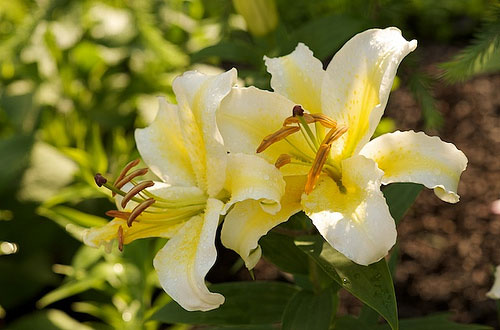





As a founding employee of Gardener's Supply, I wore many different hats over the years. Currently, I have my own company called Johnnie Brook Creative. The gardens around my home in Richmond, VT, include a large vegetable garden, seasonal greenhouse, cutting garden, perennial gardens, rock garden, shade garden, berry plantings, lots of container plants and a meadow garden. There's no place I'd rather be than in the garden.

Sierra Nevada is a fragrant Oriental variety.
Spring-planted bulbs are powerhouses of stored flower energy that start blooming just a few months after planting. There's no waiting for these plants to get established. Once they're in the ground, the bulbs sprout roots and get right down to the business of creating flowers.
One of the best things about spring-planted bulbs is that they hit their stride in late summer when the rest of the flower garden is beginning to flag. They'll add a welcome jolt of color and fragrance to your beds and borders, and especially to your home, as all of them are excellent cut flowers.
The big three spring-planted bulbs are dahlias, gladiolus and lilies:
DahliasAfter considering them awkward and gaudy for the first half of my life, I'm now a dahlia fan and my appreciation for them is growing. Our autumn frosts are coming later each year and this gives my dahlias an extra couple of weeks to bloom. I'm amazed by the extravagance of flowers produced by a hand-sized clump of dahlia tubers.
Press "play" to start the show. To see the captions and get larger photos, watch the slideshow on Flickr.
Here in zone 4/5, I start my dahlia tubers in pots about a month before planting them out into the garden. This gives them a head start; I also find it's also easier to place a plant with foliage than to reserve an empty patch of ground while waiting for the first sprouts to appear.
To learn more, read How to Grow Dahlias.
GladiolusRunner-up in the gaudy flower category would have to be the gladiolus. Though the flowers themselves are beautiful, I find their stiff form is almost impossible to integrate into my regular garden beds. So I grow them in the cutting garden, planted in rows near the zinnias. This also makes it easier to provide a little support should they begin to list.
Plant at least two or three different batches of gladiolus corms, a couple weeks apart. This way you'll have flowers coming into bloom over a six-week period, right up to frost.
A less-familiar type of gladiolus is also known as acidanthera or peacock orchids (Gladiolus callianthus). They're popular in England, where they're praised for their delicate form and intense fragrance.
To learn more, read The Basics: Gladiolus.
LiliesIn late summer, there's no flower I love more than lilies. The bulbs are a bit pricey, but when you consider that each one produces a 4-foot stalk topped by six to ten giant and powerfully fragrant blooms, they're actually a bargain.
I grow three types of lilies in my garden: trumpets, Orientals and rubrums. Because they're all marginally hardy in my zone 4/5 garden, and because I'm plagued by lily-bulb-eating rodents, I plant a fresh batch of bulbs each spring.
Trumpet lilies are the first to bloom in my garden. I have two old-time favorites, which are Regale and Golden Splendor. This year I've also ordered an orange trumpet called African Queen. Trumpets are just as fragrant as Oriental lilies, but I find their fragrance more complex and mysterious.
There are dozens of Oriental lily varieties. One of best things about having so many different varieties, that is they each have a slightly different bloom time. Plant a couple bags of mixed Oriental lily bulbs, and you'll have lilies in bloom for six to eight weeks.
Rubrum lilies are the latest lilies to bloom in my garden — sometimes as late as October. The flowers are recurved, which means the petals curl back away from the center of the flower. They're also pendulous, so are downward facing. The rubrum is a species lily, meaning the plants we grow in our gardens are similar to those that are found in the wild. For me, these lilies are just as beautiful and fragrant as the hybridized trumpets and Orientals. I have rubrums planted in my shade garden and every year they seem to appear out of nowhere, well after the rest of the garden has given up. I like that about them.
To learn more, read The Basics: Lilies.
Copyright © www.100flowers.win Botanic Garden All Rights Reserved